CBSE Previous Year Question Papers Class 12 Maths 2011 Delhi
Time allowed: 3 hours
Maximum marks : 100
General Instructions:
- All questions are compulsory.
- The question paper consists of 29 questions divided into four sections A, B, C and D. Section A comprises of 4 questions of one mark each, Section B comprises of 8 questions of two marks each, Section C comprises of 11 questions of four marks each and Section D comprises of 6 questions of six marks each.
- All questions in Section A are to be answered in one word, one sentence or as per the exact requirement of the question.
- There is no overall choice. However, internal choice has been provided in 1 question of Section A, 3 questions of Section B, 3 questions of Section C and 3 questions of Section D. You have to attempt only one of the alternatives in all such questions.
- Use of calculators is not permitted. You may ask for logarithmic tables, if required.
**Answer is not given due to the change in present syllabus
CBSE Previous Year Question Papers Class 12 Maths 2011 Delhi Set I
Section – A
Question 1.
State the reason for the relation R in the set {1, 2, 3} given by R = {(1, 2), (2, 1)} not to be transitive. [1]
Solution:
In the case of transitive relation
If (a, b) and (b, c) ϵ R
⇒ (a, c) ϵ R
Here, (1, 2) and (2, 1) ϵ R but (1, 1) ∉R.
So, R is not transitive.
Question 2.
Write the value of sin\(\left(\frac{\pi}{3}-\sin ^{-1}\left(-\frac{1}{2}\right)\right)\). [1]
Solution:
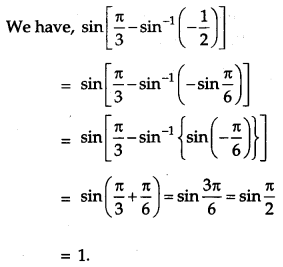
Question 3.
For a 2 × 2 matrix, A = [a
ij
], whose elements are given by a
ij
= \(\frac{i}{j}\) write the value of a
12
. [1]
Solution:
The order of the given matrix is 2 × 2
So,
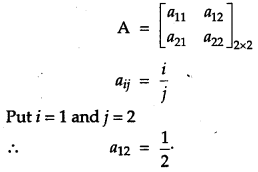
Question 4.
For what value of x, the matrix \(\left[\begin{array}{cc}{5-x} & {x+1} \\ {2} & {4}\end{array}\right]\)is singular ? [1]
Solution:
Matrix A is singular if |A| = 0
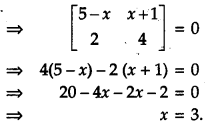
Question 5.
Write A
-1
for A = \(\left[\begin{array}{ll}{2} & {5} \\ {1} & {3}\end{array}\right]\). [1]
Solution:
We know that,
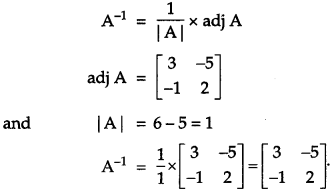
Question 6.
Write the value of \(\int \sec x(\sec x+\tan x) d x\). [1]
Solution:

Question 7.
Write the value of
 [1]
[1]
Solution:
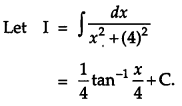
Question 8.
For what value of ‘a’ the vectors \(2 \hat{i}-3 \hat{j}+4 \hat{k}\) and \(a \hat{i}+6 \hat{j}-8 \hat{k}\) are collinear ? [1]
Solution:
Let,
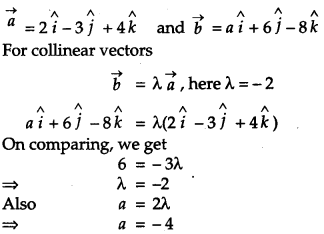
Question 9.
Write the direction cosines of the vector
![]() [1]
[1]
Solution:
Direction cosines of the vector \(-2 \hat{i}+\hat{j}-5 \hat{k}\) are
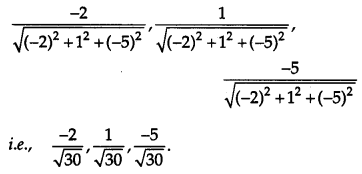
Question 10.
Write the intercept cut off by the plane 2x + y – z = 5 on x-axis. [1]
Solution:
Given equation of plane is
2x + y – z = 5 …(i)
Intercept on x-axis i.e., y = 0, z = 0
2x + 0 – 0 = 5 [from (i)]
∴ x = \(\frac{5}{2}\)
Section – B
Question 11.
Consider the binary operation * on the set {1, 2, 3, 4, 5} defined by a * b = min. {a, b}. Write the operation table of the operation *.** [4]
Question 12.
Prove the following:
 [4]
[4]
Solution:
L.H.S.
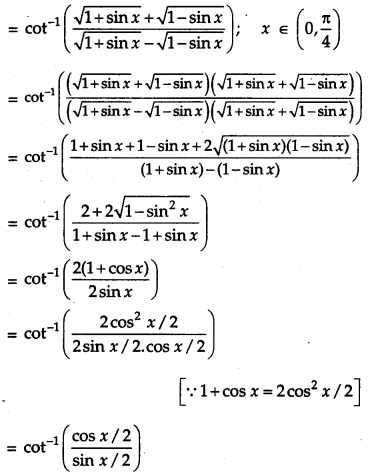
![]()
OR
Find the value of

Solution:
Given,
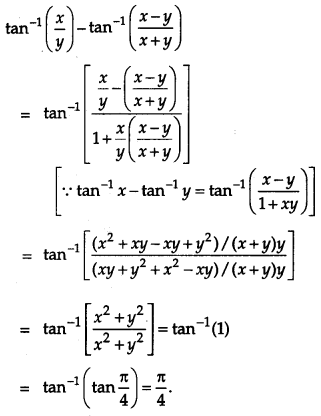
Question 13.
Using properties of determinants, prove that
 [4]
[4]
Solution:
L.H.S.
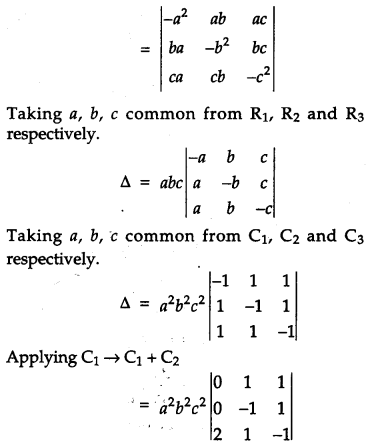

Question 14.
Find the value of ‘a’ for which the function f defined as

is continuous at x = 0. [4]
Solution:
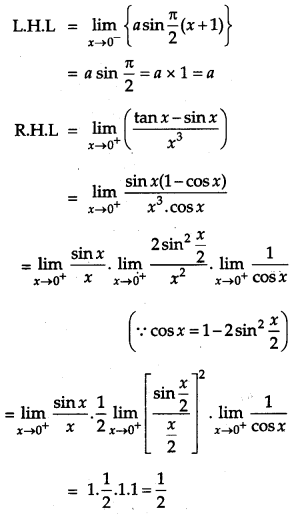

Question 15.
Differentiate \(x^{x \cos x}+\frac{x^{2}+1}{x^{2}-1}\) w.r.t. x. [4]
Solution:
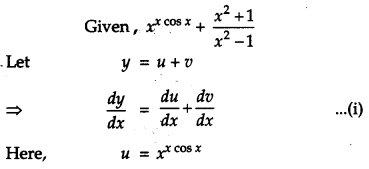
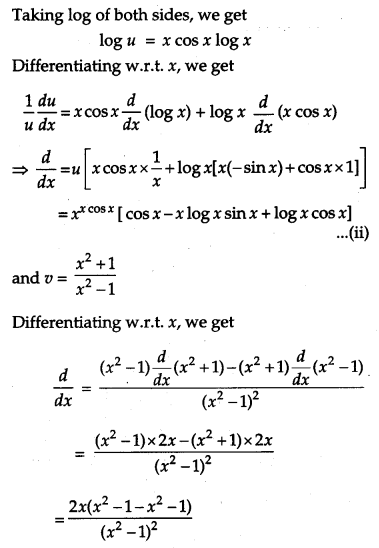
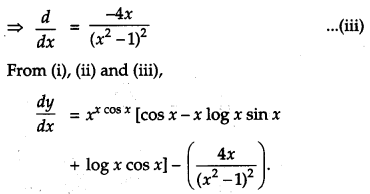
OR
If x = a(θ – sinθ), y = a(1 + cosθ) find \(\frac{d^{2} y}{d x^{2}}\).
Solution:
Given,
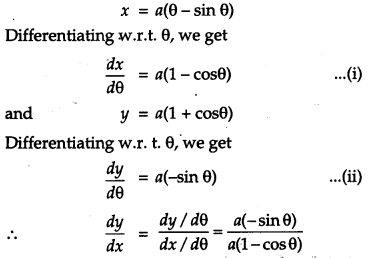
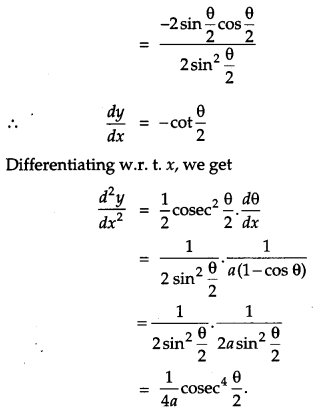
Question 16.
Sand is pouring from a pipe at the rate of 12 cm
3
/s. The falling sand forms a cone on the ground in 17. Evaluate : J such a way that the height of the cone is always one-sixth of the radius of the base. How fast is the height of the sand cone increasing when the height is 4 cm ? [4]
Solution:
Let r be the radius, h be the height and V be the volume of the sand cone.
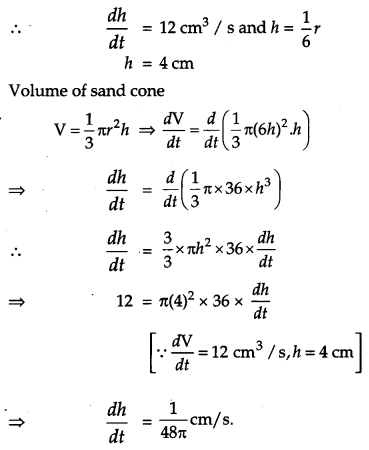
OR
Find the points on the curve x
2
+ y
2
– 2x – 3 = 0 at which the tangents are parallel to x-axis.
Solution:
When the tangent is parallel to x-axis
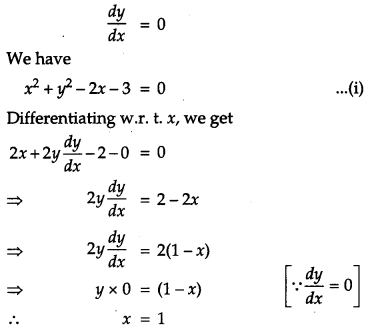
Putting, x = 1 in equation (i), we get y = ± 2
∴ The required points are (1, 2) and (1, -2).
Question 17.
Evaluate:
 [4]
[4]
Solution:
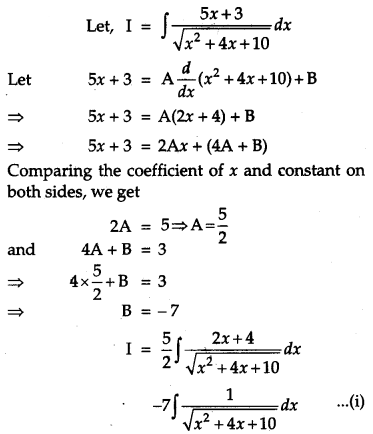
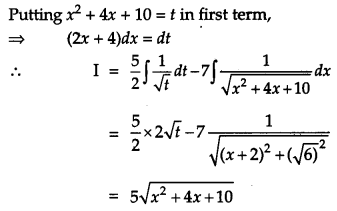
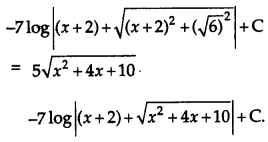
OR
Evaluate:

Solution:
Let, I
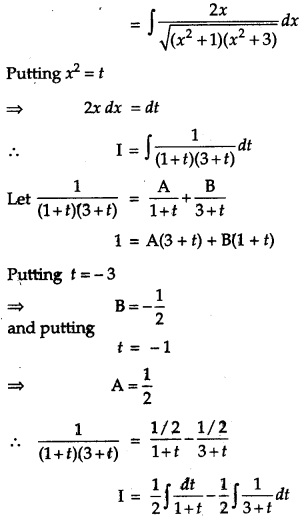
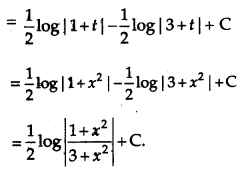
Question 18.
Solve the following differential equation:
e
x
tan y dx + (1 – e
x
)sec
2
y.dy = 0 [4]
Solution:
Given, e
x
tan y dx + (1 – e
x
) sec
2
y.dy = 0
⇒ e
x
tan y dx = – (1 – e
x
) sec
2
y.dy

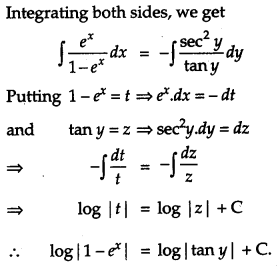
Question 19.
Solve the following differential equation:
![]() [4]
[4]
Solution:
Given,
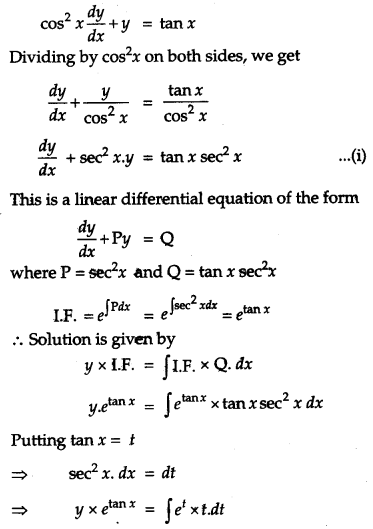
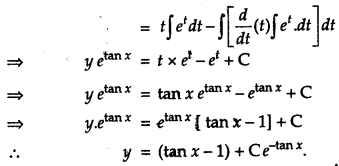
Question 20.
Find a unit vector perpendicular to each of the vectors \(\vec{a}+\vec{b} \text { and } \vec{a}-\vec{b}\),where \(\vec{a}=3 \hat{i}+2 \hat{j}+2 \hat{k}\) and \(\vec{b}=\hat{i}+2 \hat{j}-2 \hat{k}\). [4]
Solution:
Given,
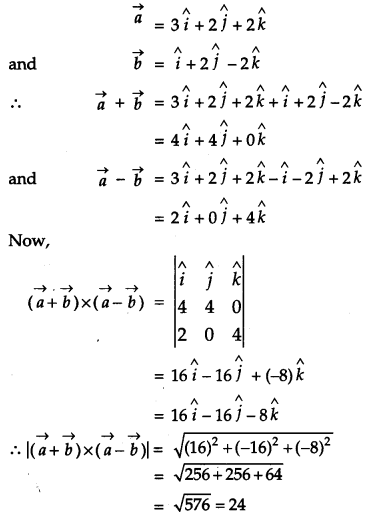
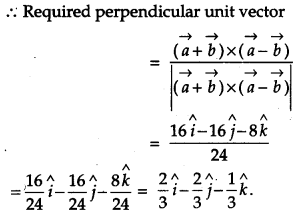
Question 21.
Find the angle between the following pair of lines:

and check whether the lines are parallel or perpendicular. [4]
Solution:
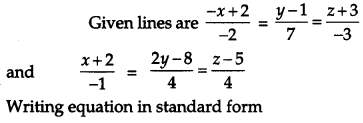
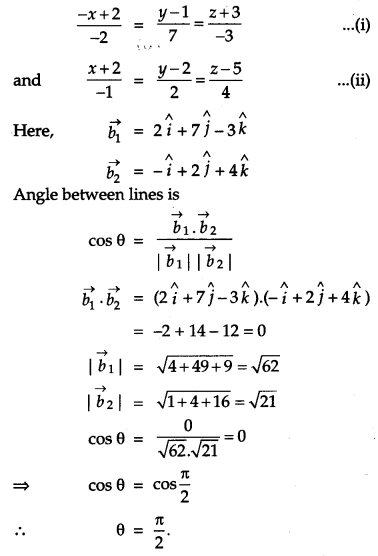
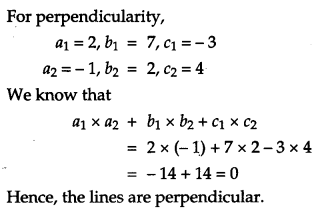
Question 22.
Probabilities of solving a specific problem independently by A and B are \(\frac{1}{2} \text { and } \frac{1}{3}\) respectively.
If both hy to solve the problem independently, find the probability that (i) the problem is solved (ii) exactly one of them solves the problem. [4]
Solution:
Given,
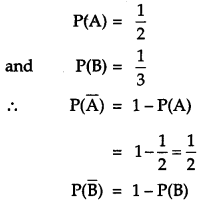
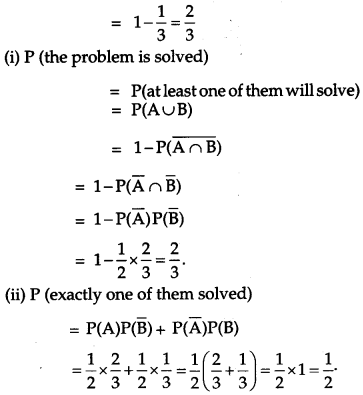
Section – C
Question 23.
Using matrix method, solve the following system of equations:
 [6]
[6]
Solution:
The given system of equations are
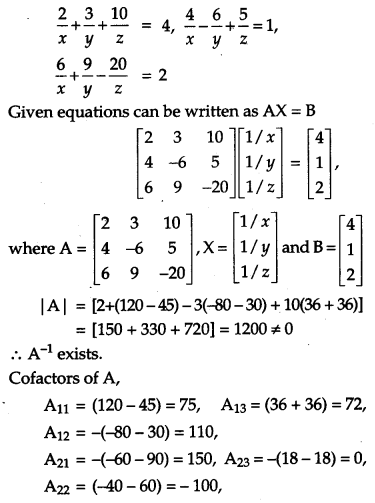
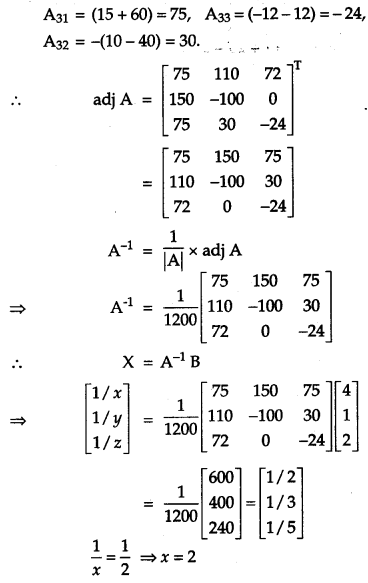
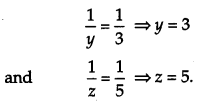
OR
Using elementary transformations, find the inverse of the matrix \(\left[\begin{array}{ccc}{1} & {3} & {-2} \\ {-3} & {0} & {-1} \\ {2} & {1} & {0}\end{array}\right]\)
Solution:
Given
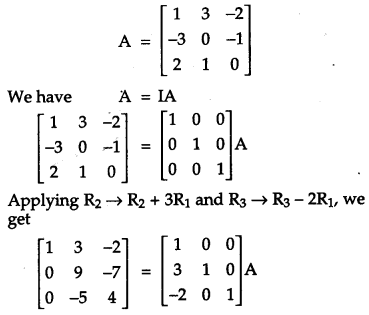
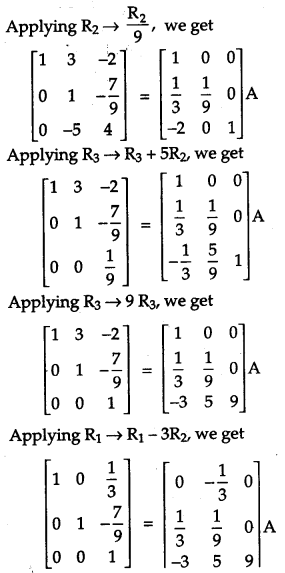
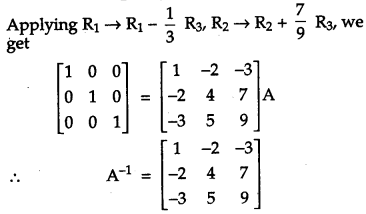
Question 24.
Show that of all the rectangles inscribed in a given fixed circle, the square has the maximum area. [6]
Solution:
Let length of rectangle be x and breadth of rectangle be y.
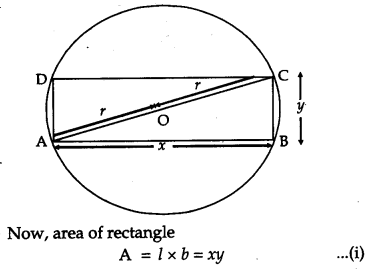
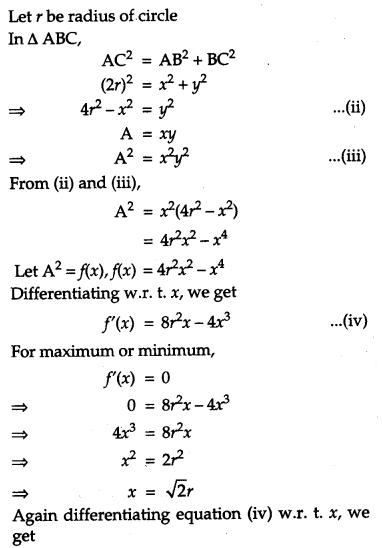
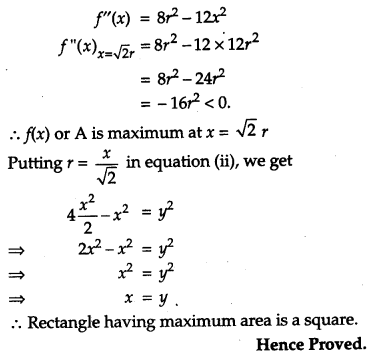
Question 25.
Using integration find the area of the triangular region whose sides have equations y = 2x + 1, y = 3x + 1 and x = 4. [6]
Solution:
Given equations are
y = 2x + 1 …(i)
y = 3x + 1 …(ii)
Table for line (i)

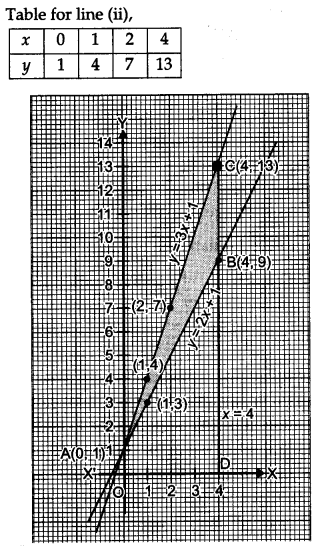
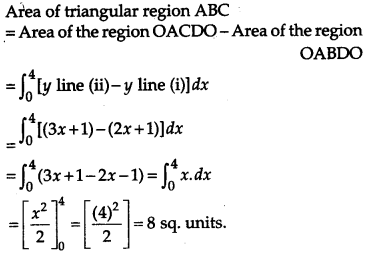
Question 26.
Evaluate: \(\int_{0}^{\pi / 2} 2 \sin x \cos x \tan ^{-1}(\sin x) d x\). [6]
Solution:
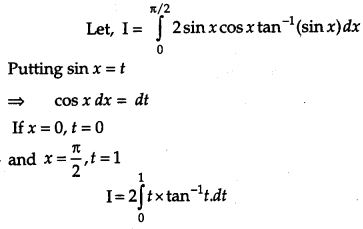
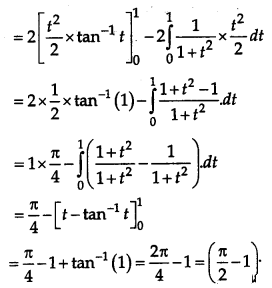
OR
Evaluate:

Solution:
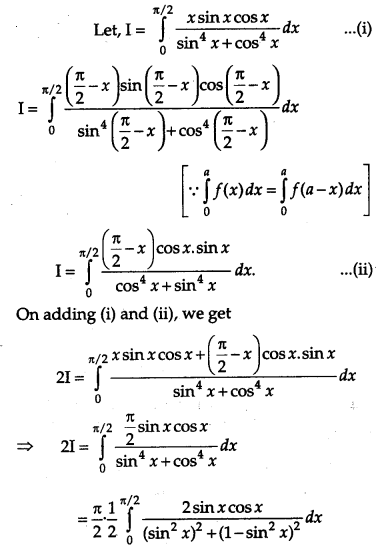
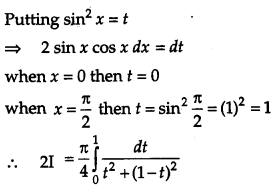
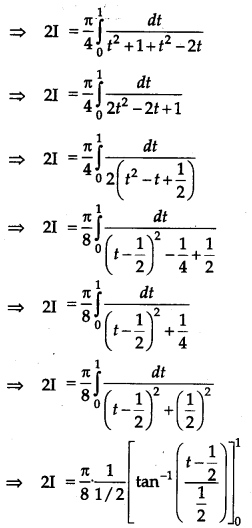
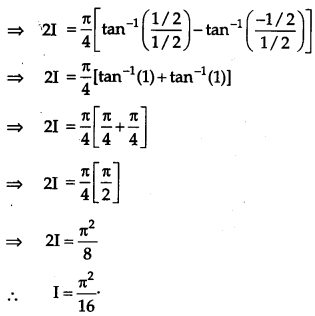
Question 27.
Find the equation of the plane which contains the line of intersection of the planes \(\vec{r} \cdot(\hat{i}+2 \hat{j}+3 \hat{k})-4=0\)\(\vec{r} \cdot(2 \hat{i}+\hat{j}-\hat{k})+5=0\) and which is perpendicular to plane \(\vec{r} \cdot(5 \hat{i}+3 \hat{j}-6 \hat{k})+8=0\). [6]
Solution:
The given equations are
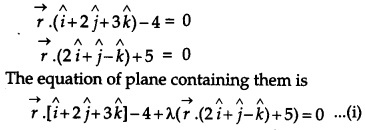
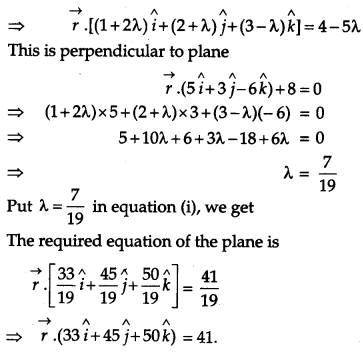
Question 28.
A factory makes tennis rackets and cricket bats. A tennis racket takes 1.5 hours of machine time and 3 hours of craftsman’s time in its making while a cricket bat takes 3 hours of machine time and 1 hour of craftsman’s time. In a day, the factory has the availability of not more than 42 hours of machine time and 24 hours of craftsman’s time. If the profit on a racket and on a bat is ₹ 20 and ₹ 10 respectively, find the number of tennis rackets and circket bats that the factory must manufacture to earn the maximum profit. Make it as an L.P.P. and solve graphically. [6]
Solution:
Let x be the number of tennis rackets and y that of cricket bats produced in one day in the factory.
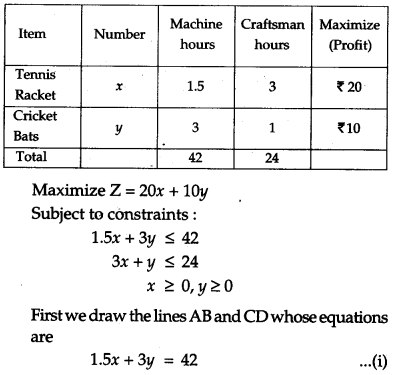
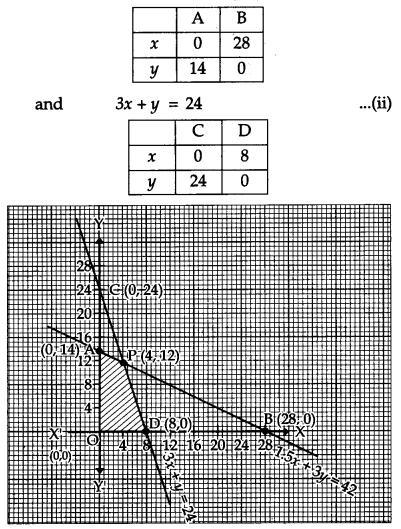
The feasible region is ODPAO which is shaded in the figure.
The vertices of the feasible region are O(0, 0), D(8, 0), P (4, 12) and A(0, 14).
P is the point of intersection of the lines .
1.5x + 3y = 42 and 3x + y = 24
Solving these equations, we get point P(4, 12). The value of objective function Z = 20x + 10y at these vertices are as follows:
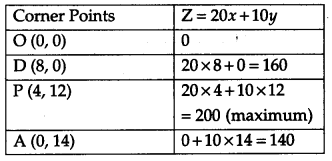
For maximum profit ₹ 200, 4 tennis rackets and 12 cricket bats should be produced.
Question 29.
Suppose 5% of men and 0.25% of women have grey hair. A grey haired person is selected at random. What is the probability of this person being male ? Assume that there are equal number of males and females. [6]
Solution:
Let E
1
and E
1
be the number of men and women respectively.
∴ Probability of men and women
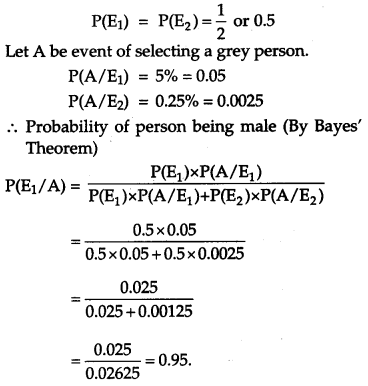
CBSE Previous Year Question Papers Class 12 Maths 2011 Delhi Set II
Note: Except for the following questions, all the remaining questions have been asked in previous set.
Section – A
Question 9.
Write the value of tan
-1
\(\left[\tan \frac{3 \pi}{4}\right]\). [1]
Solution:
We know that tan
-1
\(\left[\tan \frac{3 \pi}{4}\right]\) = x if
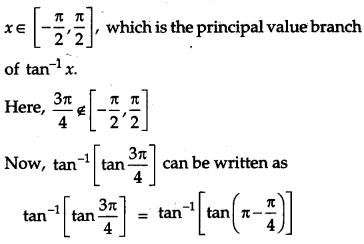
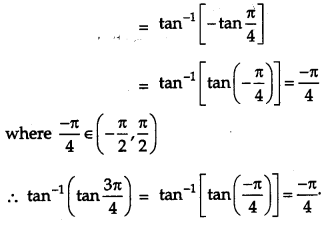
Question 10.
Write the value of
 [1]
[1]
Solution:
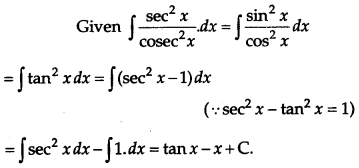
Section – B
Question 15.
Form the differential equation of the family of parabolas having vertex at the origin and axis along positive y-axis. [4]
Solution:
The equation of the family of parabolas having vertex at the origin and axis along positive y-axis.
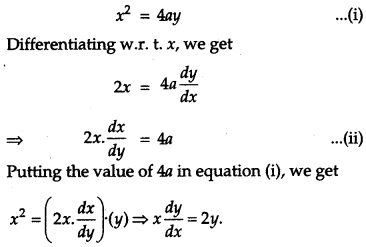
Question 16.
Find a vector of magnitude 5 units and parallel to the resultant of the vectors \(\vec{a}=2 \hat{i}+3 \hat{j}-\hat{k}\) and \(\vec{b}=\hat{i}-2 \hat{j}+\hat{k}\). [4]
Solution:
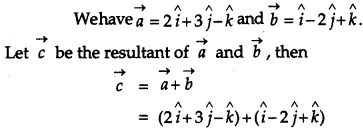
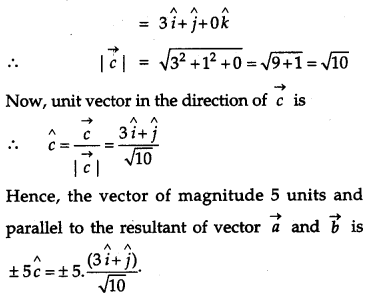
Question 19.
If the function f(x) given by

is continuous at x = 1, find the values of a and b. [4]
Solution:
Since f is continuous at x = 1, therefore
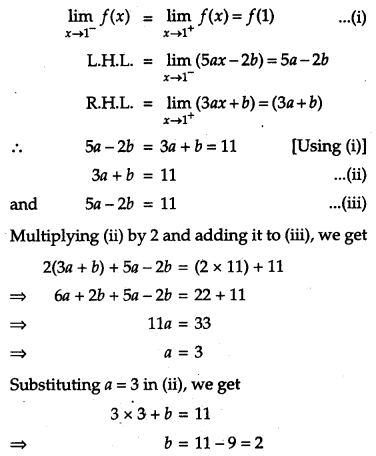
Thus, a = 3 and b = 2 will make f(x) continuous at x = 1.
Question 20.
Using properties of determinants, prove the following:
 [4]
[4]
Solution:
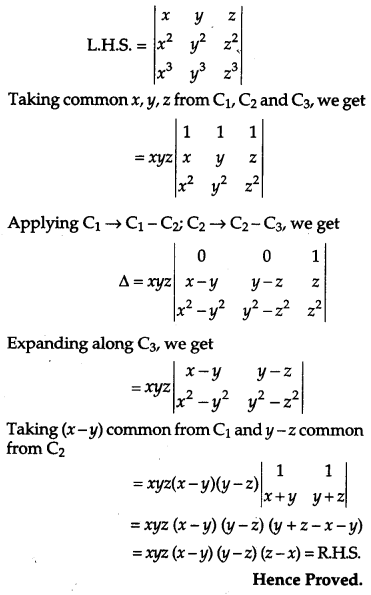
Secton – C
Question 23.
Bag I contains 3 red and 4 black balls and Bag II contains 5 red and 6 black balls. One ball is drawn at random from one of the bags and is found to be red. Find the probability that it was drawn from Bag II. [6]
Solution:
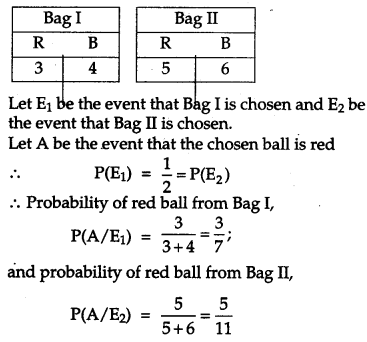
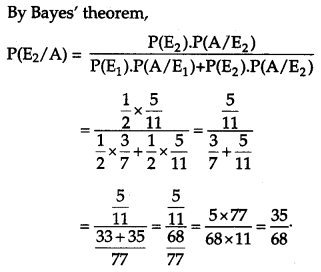
Question 29.
Show that of all the rectangles with a given perimeter, the square has the largest area. [6]
Solution:
Let x and y be the length and breadth of the rectangle whose perimeter is given 4a (say)
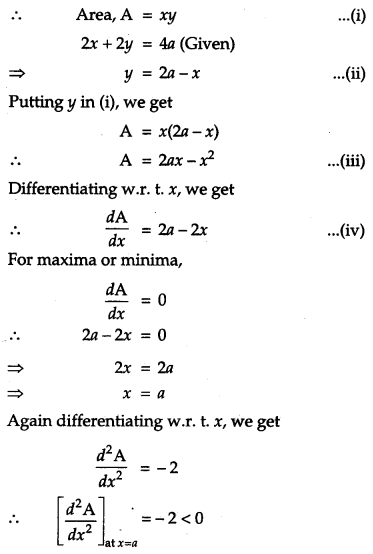

Hence, It is proved that all the rectangles with a given perimeter, the square has the largest area.
Hence Proved.
CBSE Previous Year Question Papers Class 12 Maths 2011 Delhi Set III
Note: Except for the following questions, all the remaining questions have been asked in previous sets.
Section – A
Question 1.
Write the value of cos
-1
\(\left(\cos \frac{7 \pi}{6}\right)\). [1]
Solution:
we know that cos
-1
(cos x) if x ϵ [0, π], which is the principal value branch of cos
-1
x.
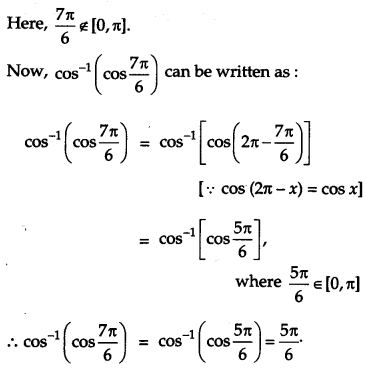
Question 2.
Write the value of
![]() [1]
[1]
Solution:
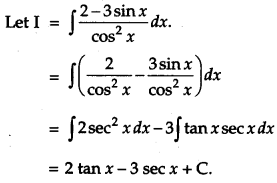
Section – B
Question 11.
Using properties of determinants, prove the following:
 [4]
[4]
Solution:
Taking L.H.S.
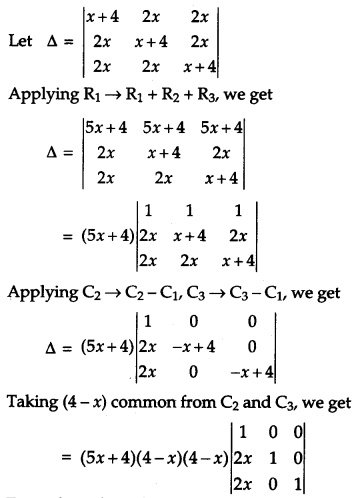
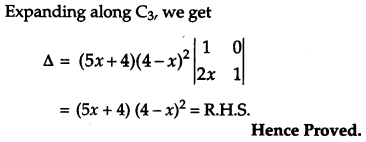
Question 12.
Find the value of a and b such that the following function f(x) is a continuous function:
 [4]
[4]
Solution:
If f is a continuous function, f is continuous at all real numbers.
In particular, f(x) is continuous at x = 2 and x = 10.
Since f is continuous at x = 2, we obtain
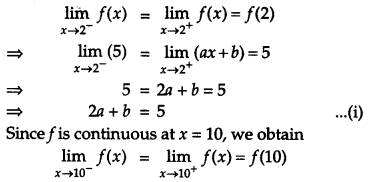
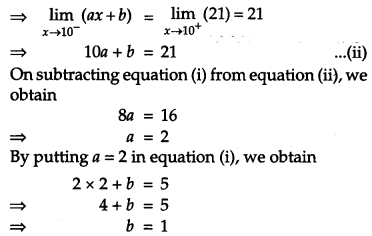
Therefore, the values of a and b for which f(x) is a continuous function are 2 and 1 respectively.
Question 13.
Solve the following differential equation :
(1 + y
2
) (1 + log x)dx + xdy = 0 [4]
Solution:
Given (1 + y
2
) (1 + log x) dx + xdy = 0
⇒ (1 + y
2
) (1 + log x) dx = -xdy
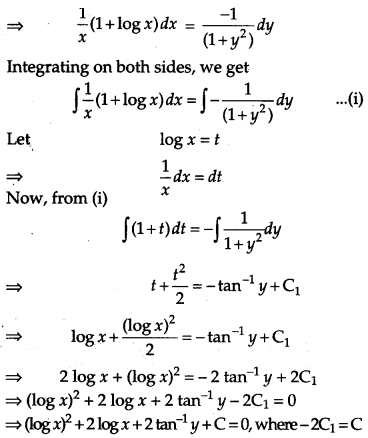
Question 14.
If two vectors \(\vec{a} \text { and } \vec{b}\) are such that \(|\vec{a}|\) = 2, \(|\vec{b}|\) = 1 and \(\vec{a} \cdot \vec{b}=1\), then find the value of \((3 \vec{a}-5 \vec{b}) \cdot(2 \vec{a}+7 \vec{b})\). [4]
Solution:
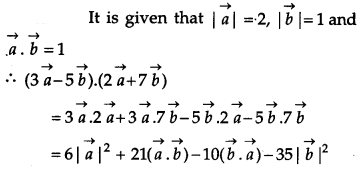

Section – C
Question 23.
A man is known to speak truth 3 out of 4 times. He throws a die and reports that it is a six. Find the probability that it is actually a six. [6]
Solution:
Let E be the event that the man reports that six occurs in the throwing of a die and let Si be the event that six occurs and S
2
be the event that six does not occur,
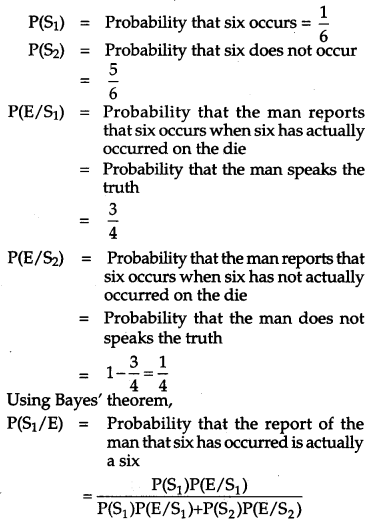
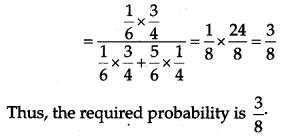
Question 24.
Show that of all the rectangles of given area, the square has the smallest perimeter. [6]
Solution:
Let l and b respectively be the length and the breadth of the rectangle of given area A.
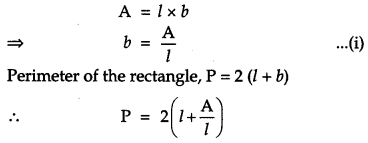
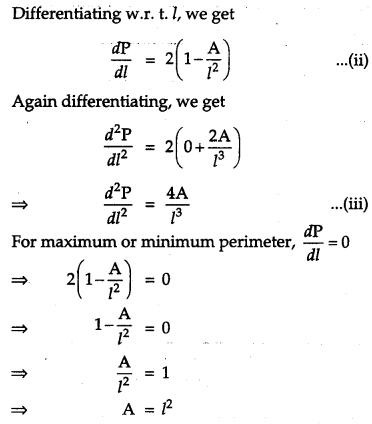
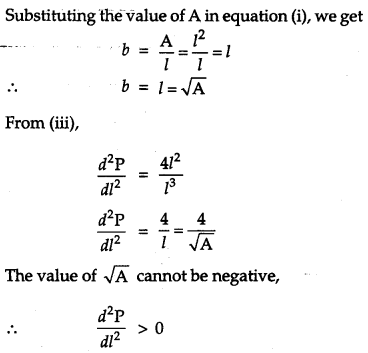
Hence, of all the rectangles of given area, the square has the smallest perimeter.
Hence Proved.